Exploring the Secrets of Delicious Japanese Seafood
At FOODEX JAPAN 2024, Asia's largest food and beverage exhibition, Japanese Marine Products such as Hokkaido scallops were celebrated.
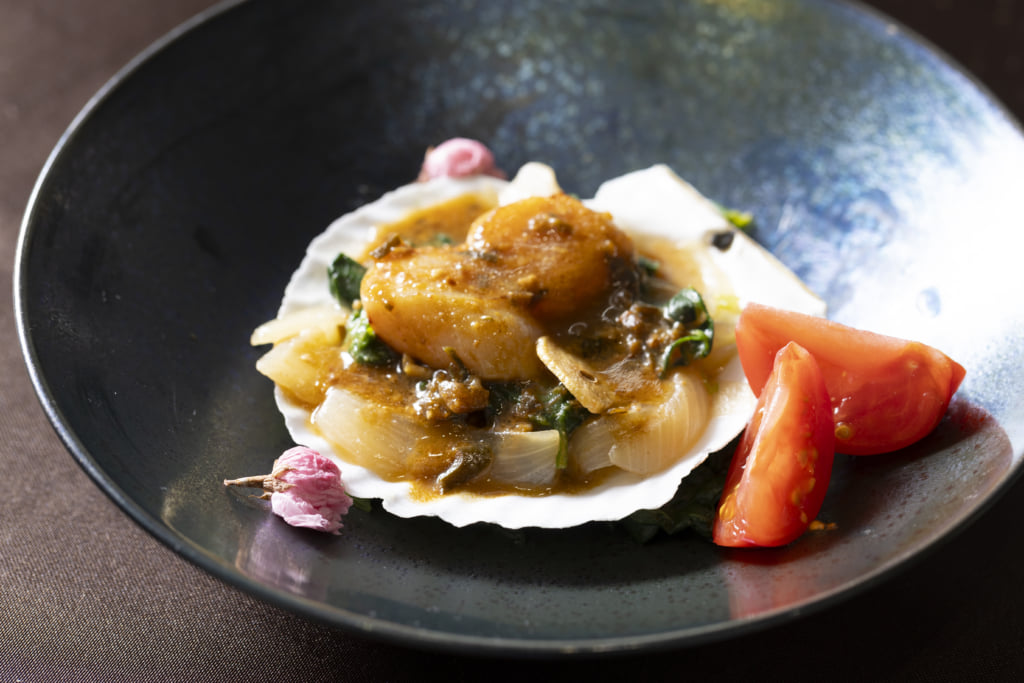
Sushi is a Japanese food that is loved around the world, consisting of fresh seafood eaten raw. It is rare to find a country in the world that eats raw fish, and the freshness of Japanese marine products is one of the reasons why sushi has taken root in Japan.
In this article, we take a closer look at the appeal of Japanese marine products, as seen at the networking reception at FOODEX JAPAN 2024, Asia’s largest food and beverage trade show, held in Tokyo.
Networking Reception to Discover the Appeal of Japanese Seafood
FOODEX JAPAN 2024, Asia’s largest food and beverage exhibition, was held at Tokyo Big Sight for four days from March 5 to 8, 2024. On March 5, the first day of the event, a networking reception was held by the Japanese Ministry of Agriculture, Forestry and Fisheries. The theme of this year’s event was ‘Japanese Marine Products.’
The event invited buyers from around the world and provided networking opportunities, including direct discussions with Japanese fishery-related businesses, with the aim of further expanding exports of Japanese marine products.

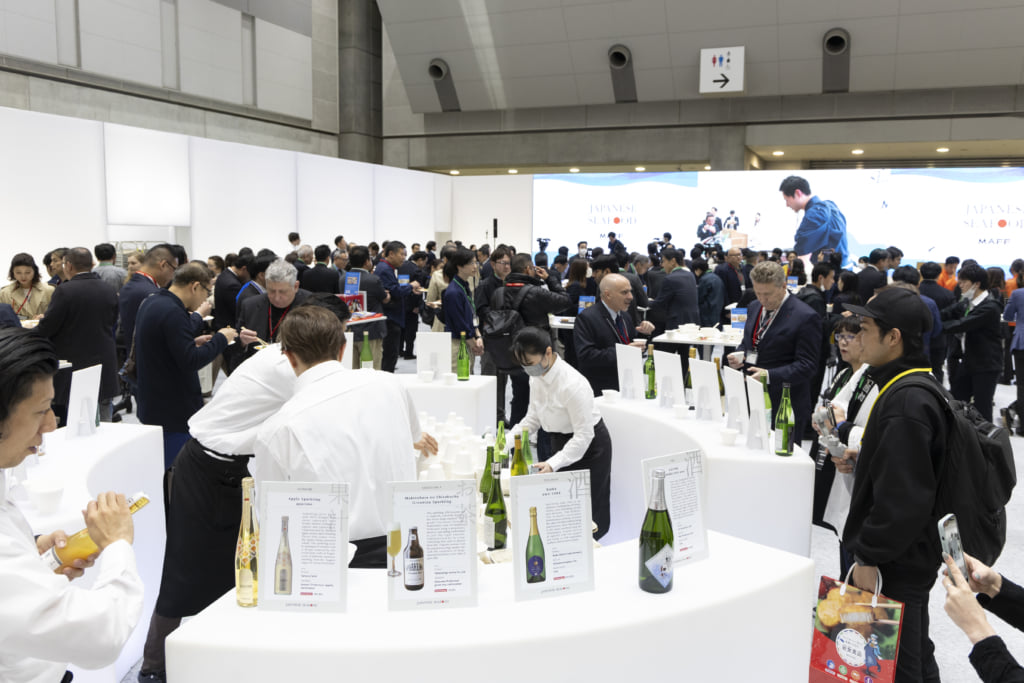
The reception also included dishes featuring Hokkaido scallops and Japan’s representative fish, such as yellowtail and sea bream. Events included a talk session between famous Japanese chefs and fishermen, and tasting sessions at a bar area where visitors could enjoy Japanese sake and wine.
Buyers were invited from a wide range of countries and regions, including the United States, Canada, Spain, and other Western countries; Indonesia, the Philippines, Thailand, Vietnam, Singapore, and other Southeast Asian countries; as well as the UAE and India.
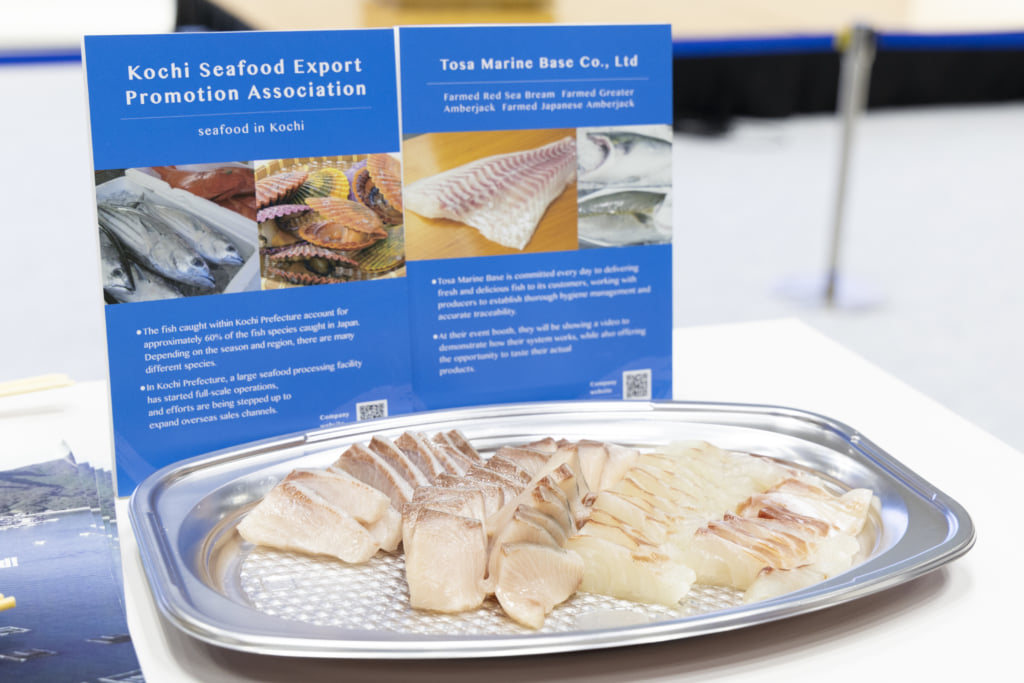
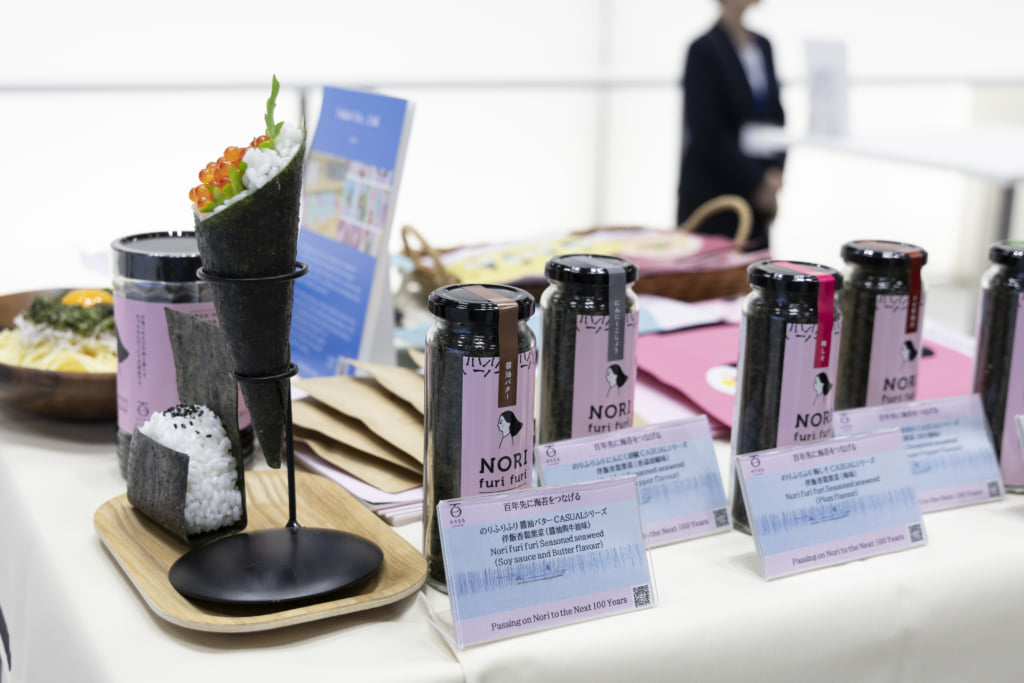

Business operators gave enthusiastic presentations on the quality of Japanese marine products, and on processing techniques. Overseas buyers also asked questions about production methods and characteristics, as well as matching and arranging with different cuisines.
Why is Japanese Seafood so Delicious?
Why do Japanese seafood products taste so good?
The first reason for this is the ‘environment’ in which marine products are produced. Japan is an island nation surrounded by sea. The topography, marine environment, climate, and other characteristics of each region lead to there being a wide variety in the marine products available. Moreover, the four seasons allow for many types of marine products to be caught throughout the year, and each region has attractive local cuisine that uses the products that are actively being landed.
The second reason is traditional preservation methods and techniques.
Japanese people have lived in harmony with the sea since ancient times, and have developed the best fishing methods, tools, and preservation techniques throughout their long history, with traditional methods of preservation being handed down from generation to generation among fishermen.
One of them is ikejime, a method for killing fish which originated in Japan and maintains the quality of the flesh. In this technique, live fish are quickly processed to maintain freshness. To achieve this, a special wire-like device is used to spike hindbrain and cause immediate brain death.
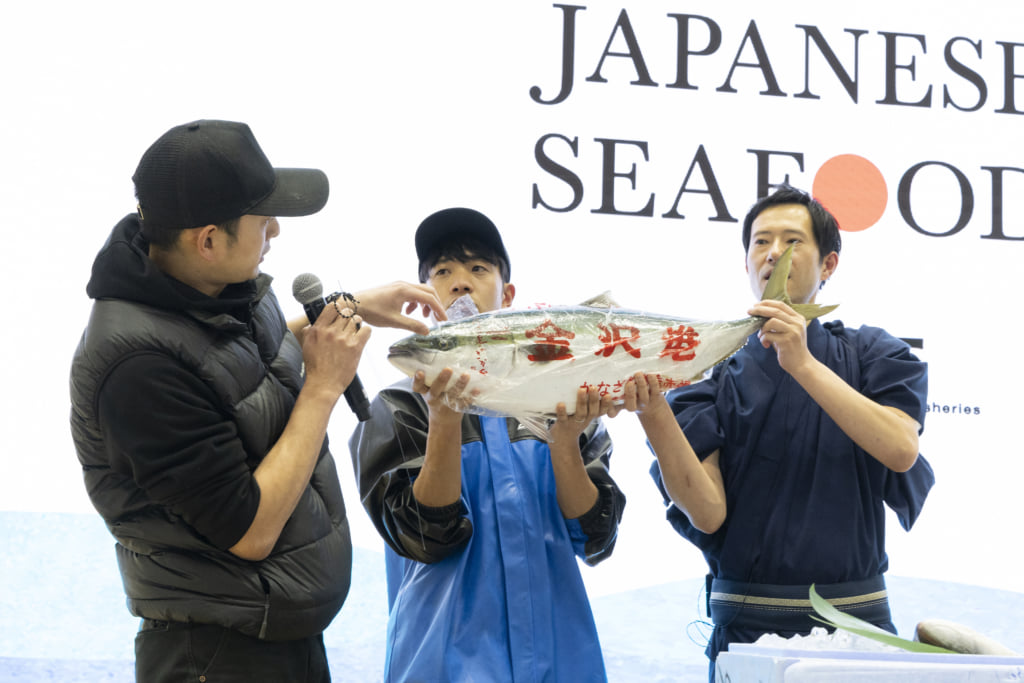
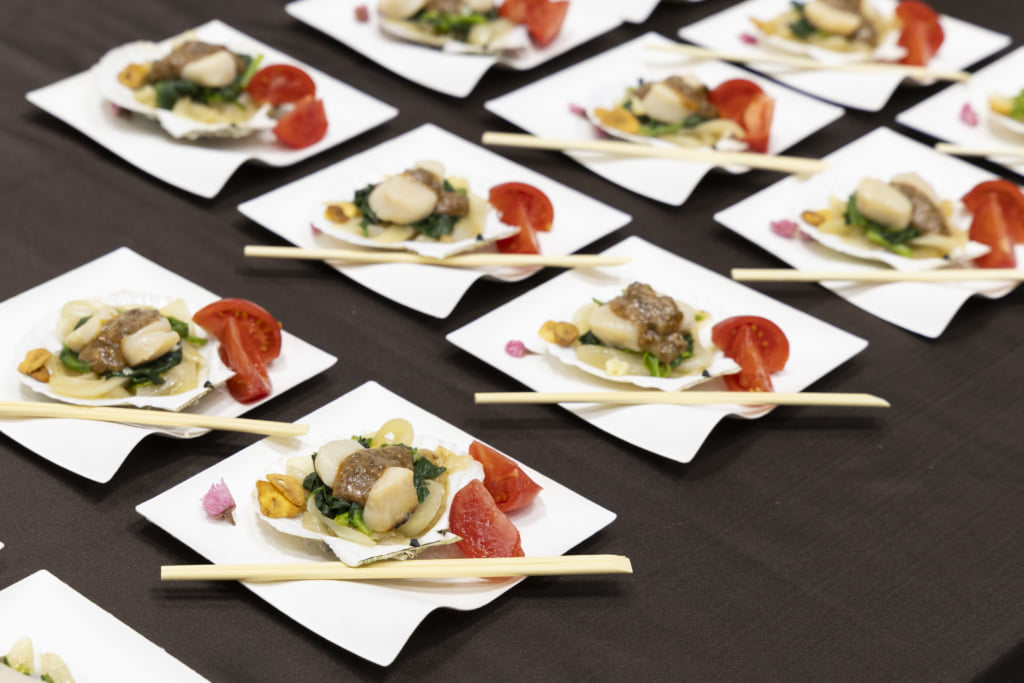
Takeshi Nakashoji, who runs a fresh fish store on the Noto Peninsula of Ishikawa Prefecture that has been in business for more than 70 years, said:
‘The nerves of the fish are invisible to the eye. The ‘live-fishing’ technique relies on the fisherman’s senses, which is why experience is so important.’
Other technologies introduced included that for flash-freezing conger eel landed at minus 40 degrees Celsius and ‘green perch,’ a preservation sheet made of a special fiber used in the fishing industry.
Traditional techniques and ever-evolving preservation technologies are what support the quality of Japanese marine products. These techniques also have advantages when exporting overseas, making it possible to export seafood that is as fresh as possible at the time of landing.
Arranging with Ingredients Opens Up Even More Possibilities
Chef Eiryo Kudo, former chef of Official Residence, gave a cooking demonstration at the venue.
To enjoy the appeal of Japanese marine products, it is good to eat the ingredients as they are, but matching them with other ingredients, such as Japanese fermented foods like miso and soy sauce, also opens up new possibilities. In addition, citrus fruits, spices, and other ingredients can expand the range of dishes with just a little effort.
Here are some of the dishes served at the reception.

Grilled Scallops with Miso Garlic Butter Sauce
In this dish, thick and flavorful Hokkaido scallops are simply grilled with salt and pepper. The scallops are served with a savory sauce made from garlic butter, miso, and soy sauce, which are traditional Japanese fermented foods, as well as aromatic mirin (sweet sake), yuzu juice, and lemon juice.
The key to scallops that are fresh enough to be served as sashimi is not to overcook them. Chef Kudo says, ‘Use rare scallops that are slightly browned on both sides. The miso used in the sauce goes well not only with Japanese cuisine, but also with French and Italian cuisine.’
As he says, scallops are a perfect match for French, Italian, and other Western cuisines, as well as for spicy Asian dishes. A unique dish can be completed by adding a pinch of Japanese seasonings such as miso or soy sauce.
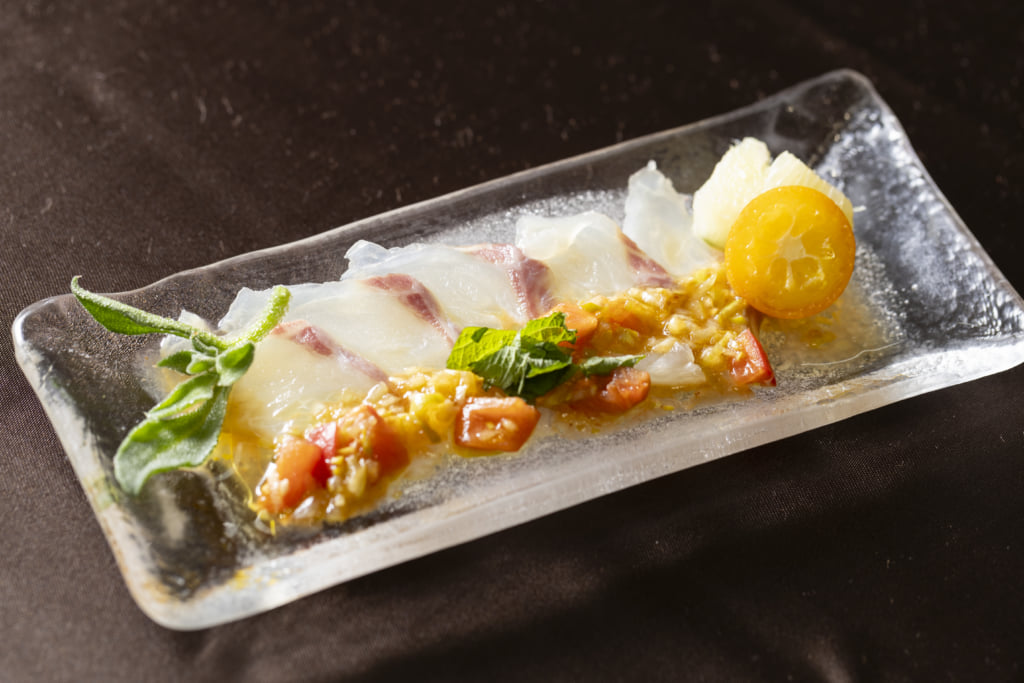
Sea Bream Carpaccio with Plum and Shiso Dressing
Fresh seafood should be enjoyed as sashimi. Fresh sea bream is here served in a carpaccio style with a special dressing of plum paste, shiso leaves, fruit tomatoes, ponzu (Japanese citrus juice), and olive oil. The dish is garnished with Kumamoto citrus fruits, yuzu (a citrus produced in Kumamoto Prefecture) and kumquat. The refreshing and odorless sea bream goes well with the fresh aroma of citrus fruits, and marries perfectly with a glass of chilled white wine or sparkling sake.
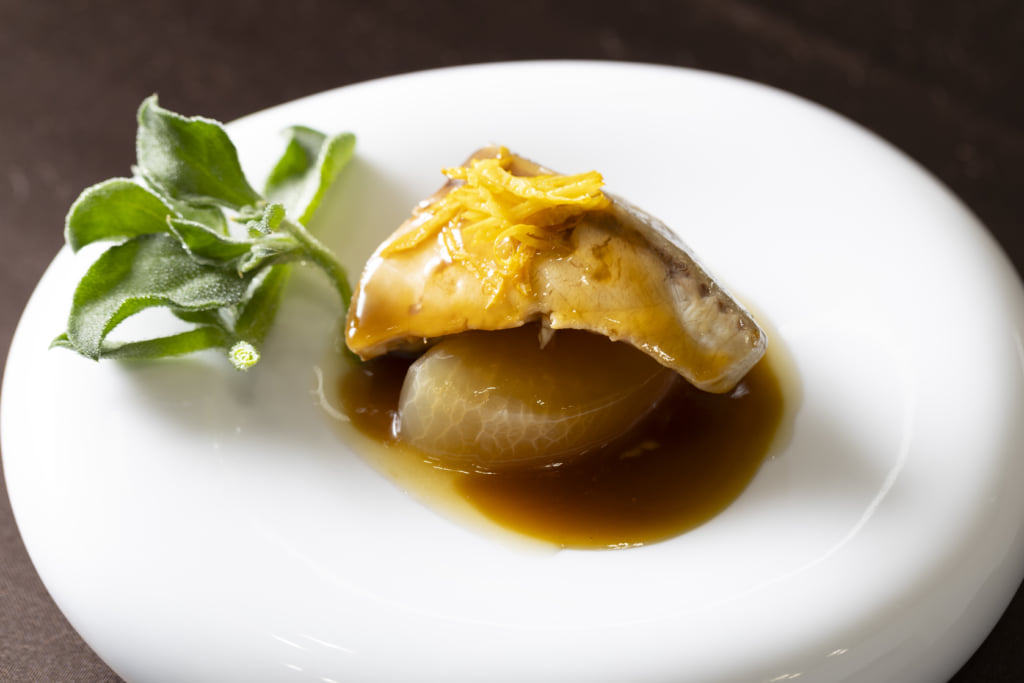
Grilled Yellowtail Daikon with Teriyaki Sauce and Yuzu Flavor
One of the signature winter dishes in Japan is Buri Daikon. Buri (yellowtail) from Wajima, Ishikawa Prefecture, is fatty and full of flavor the moment you put it in your mouth. The beautifully fluffy, marinated and grilled Buri is cooked in a salt koji broth to bring out the natural flavor of the ingredients, and the daikon radish slowly simmered in ichiban dashi (Japanese soup stock) melts in your mouth. The sweet and spicy teriyaki sauce and fresh yuzu aroma will whet your appetite. Pair it with a glass of sake.
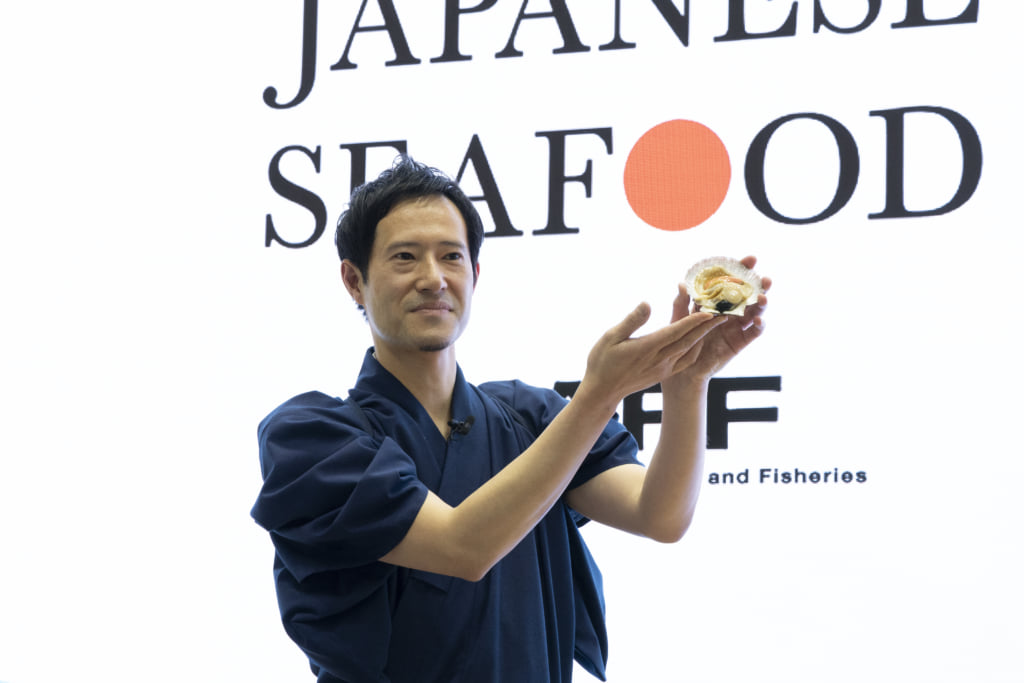


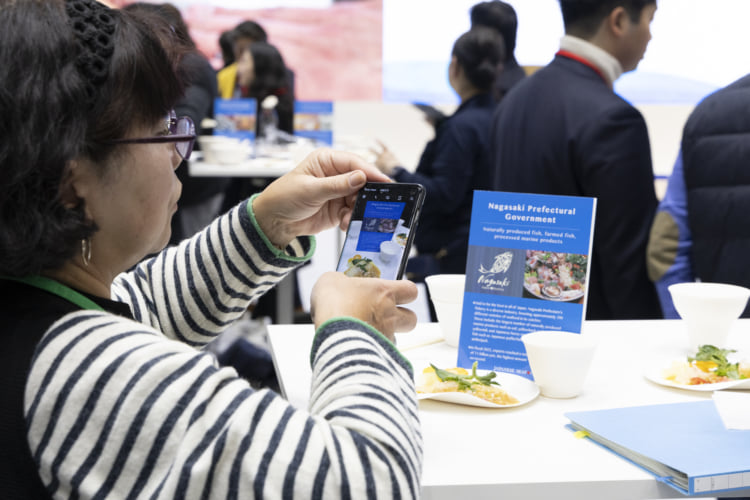
Buyers who came to the event seemed to be surprised by the new flavors, commenting, ‘I have never tasted this before,’ and, ‘Miso and scallops go well together. It would be interesting to match the scallops not only with classic Japanese cuisine, but also with dishes and ingredients from around the world.’
The Marriage of Sake and Japanese Wine
Sake was served to accompany the food, with the bar in the center of the venue lined with sake and Japanese wine from various regions of Japan, as well as juices and teas made from Japanese fruit.
Sake carefully selected for pairing with the dishes was made at sake breweries in Ishikawa, Toyama, and Fukushima, which are famous for their sake production. For the toast, AWASAKE, a sparkling sake that has been gaining recognition overseas in recent years, was also served.
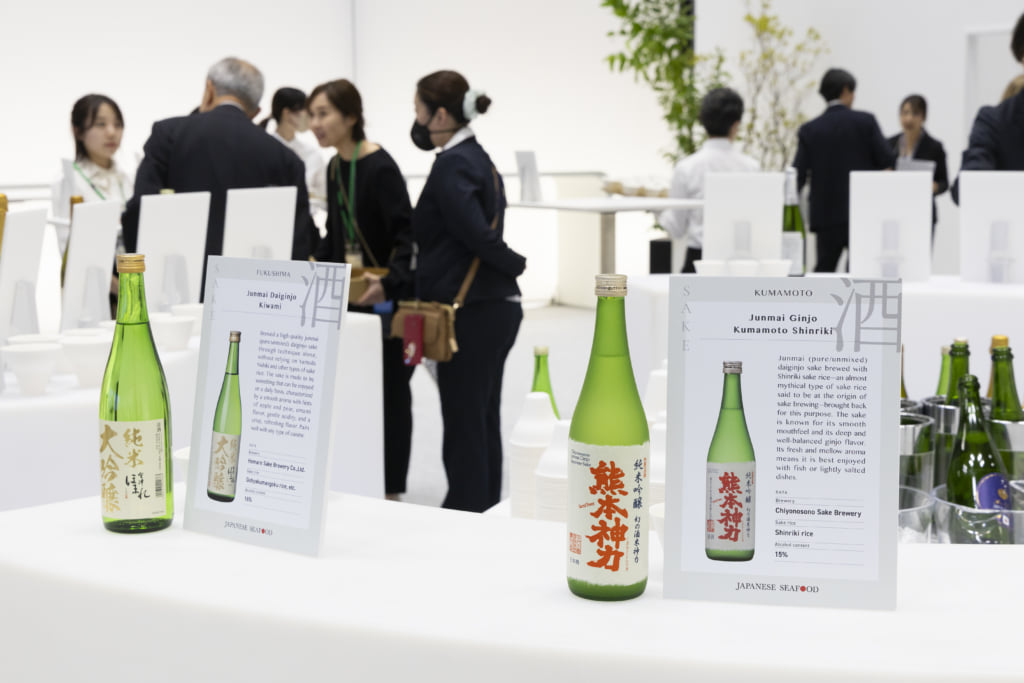

Buyers who enjoyed the pairing of sake with the food commented on the uniqueness of the beverage, asking, ‘Is this really sake?’ Like Japanese marine products, domestically produced sake and beverages are also evolving day by day. We will continue to focus on unique flavors, food pairings, and design features.
At the reception, Minister of Agriculture, Forestry and Fisheries Sakamoto had this to say about the future of Japan’s fisheries industry:
‘Since the end of last year, the Ministry of Agriculture, Forestry and Fisheries (MAFF) has invited overseas buyers to visit domestic production areas in Hokkaido, Tohoku, and other regions, and has dispatched domestic processing companies and others to Vietnam for inspection tours and business meetings in order to promote the diversification of export destinations for scallops and other marine products. Through these efforts, the value of fresh scallops and other products when exported to Vietnam and Taiwan has increased steadily, approximately five-fold and two-fold, respectively, over the same period last year. We hope that opportunities such as this reception will continue to promote exchanges and business negotiations among the parties concerned and further diversify export destinations in the future.’

Overseas buyers exited the venue, which was overflowing with enthusiasm from start to finish, with smiles on their faces. From the looks of them, it seems that they gained a great deal from this reception.
We hope that exports of Japanese marine products overseas will further accelerate and become a new trend.
TRENDING
-
The Tattoos that Marked the Criminals of the Edo Period
Traditional tattoos were strong signifiers; murderers had head tattoos, while theft might result in an arm tattoo.

-
Colour Photos of Yakuza Tattoos from the Meiji Period
19th-century photographs have captured the usually hidden tattoos that covered the bodies of the members of Japanese organised crime gangs.

-
The Trendiest ‘Sento’ and Saunas in Tokyo
The bath culture remains vibrant in the capital city, where public baths and saunas designed by renowned architects are continuously opening.

-
Rituals of Ancient Gay Shunga Erotica
Shunga was prolific in Japan during the Edo period, with ‘nanshoku’ referring to the depiction of homosexual erotica.

-
‘LSD: Dream Emulator’, an Avant-Garde Game Released on PlayStation
In this video game created by Osamu Sato and released in 1998, the player explores the surrealist, psychedelic environment of a dream.





